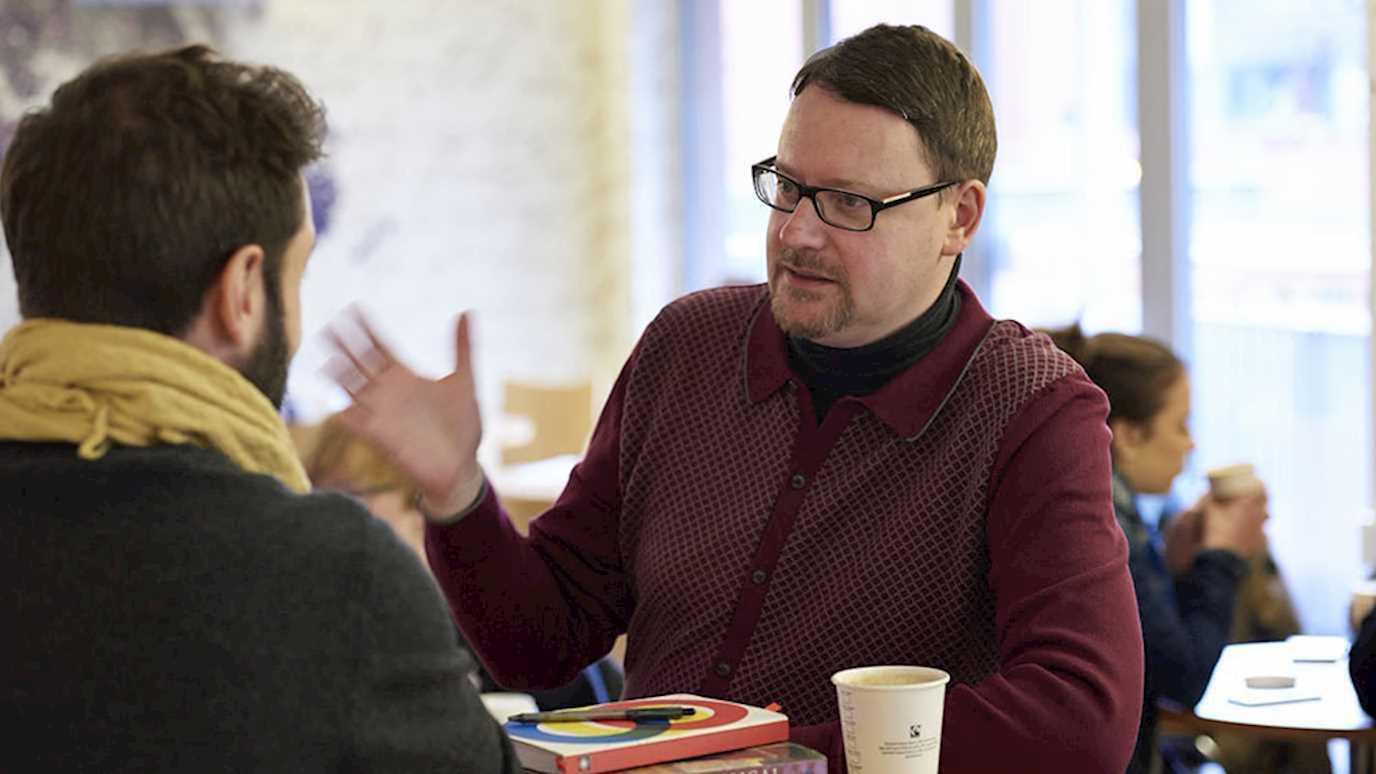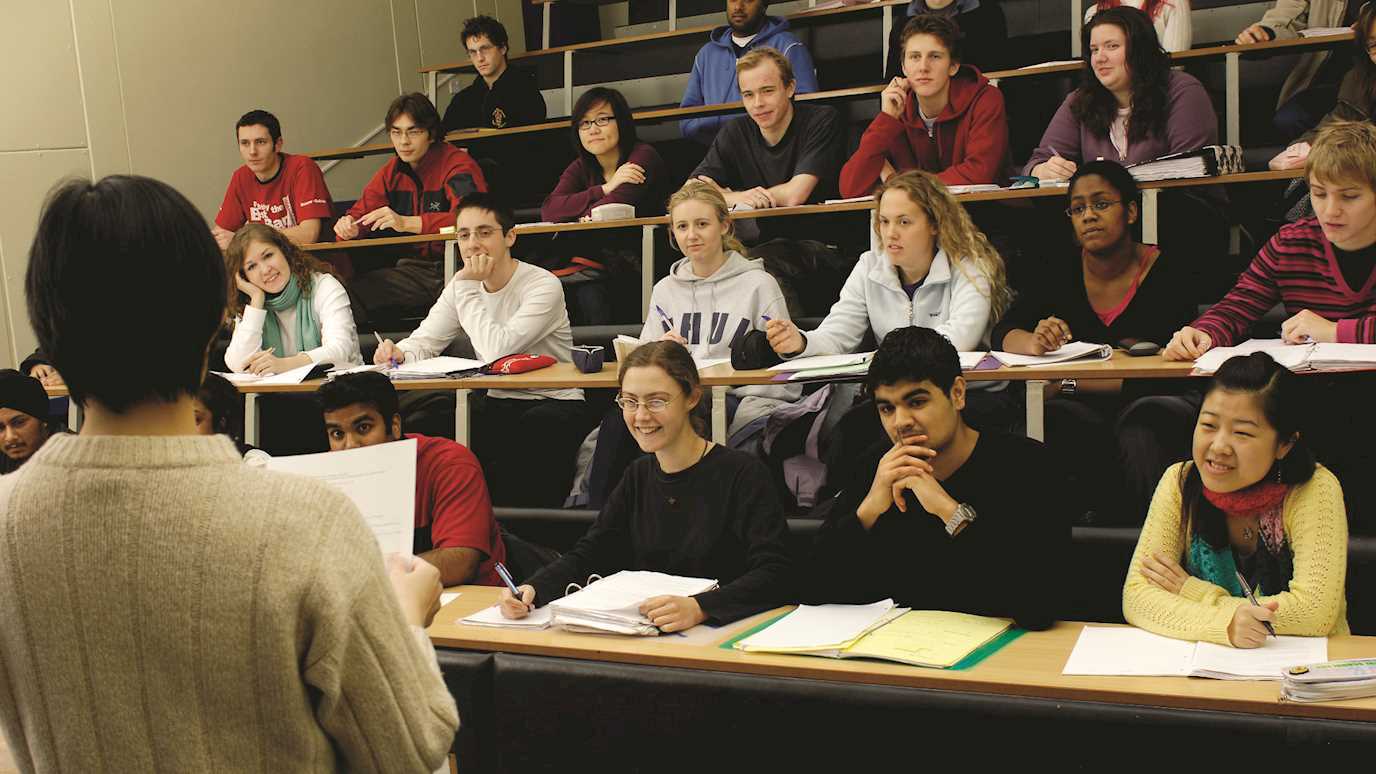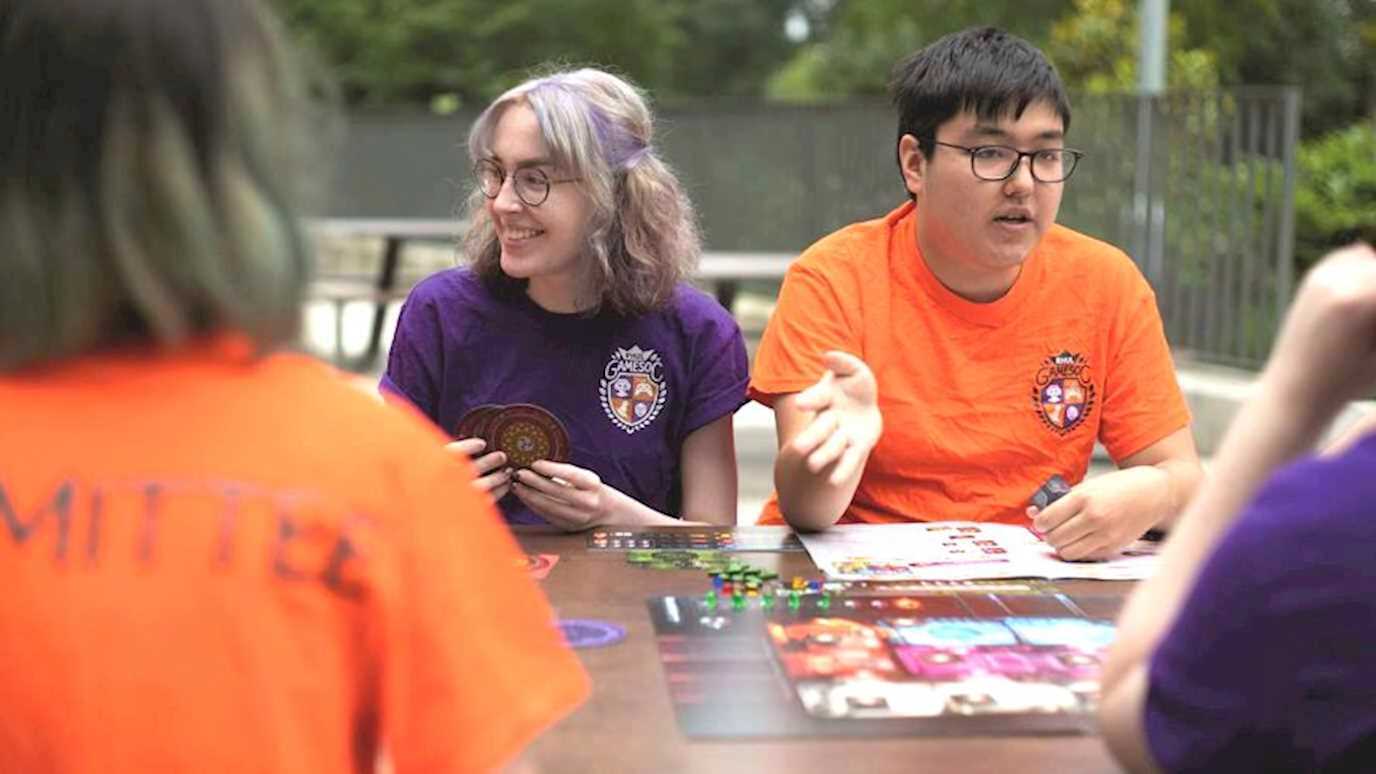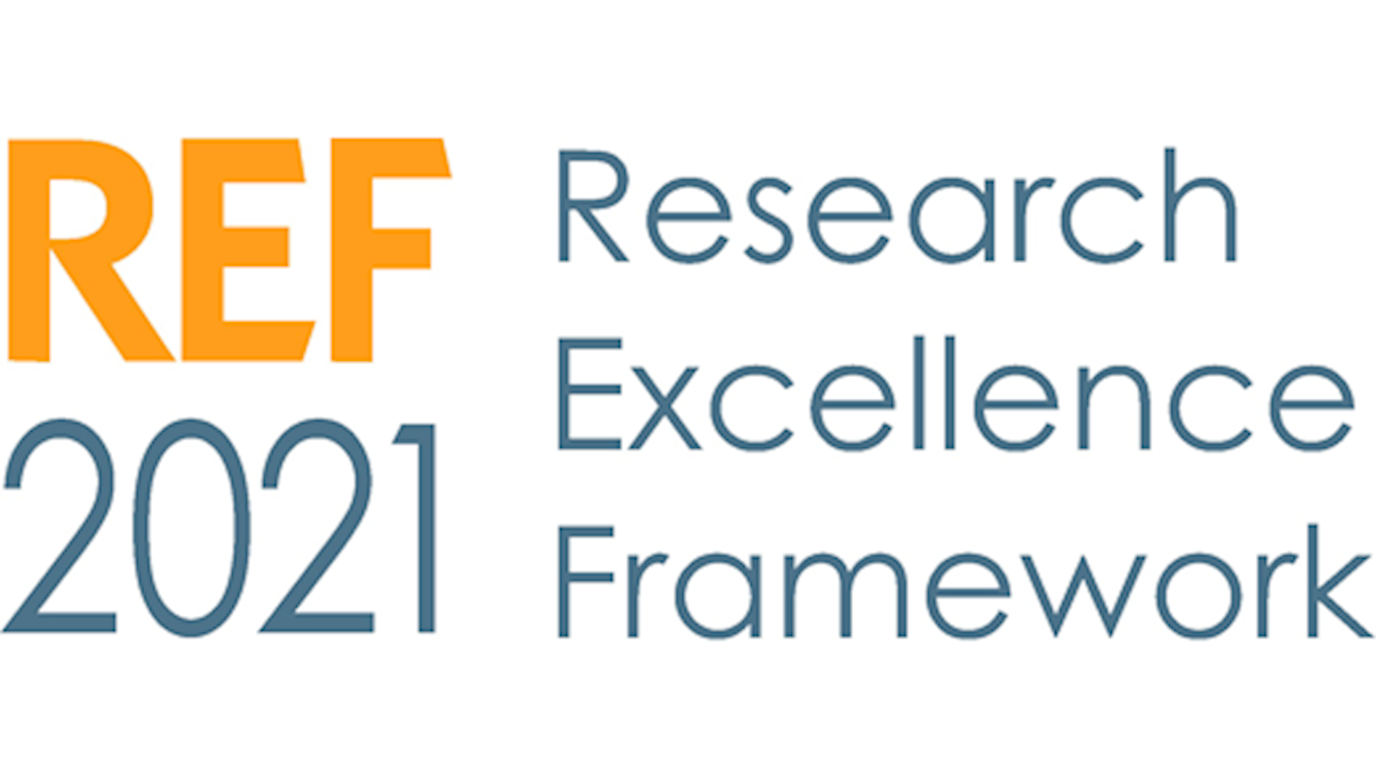Course options
Key information
Duration: 3 years full time
UCAS code: GF13
Institution code: R72
Campus: Egham
The course
Mathematics and Physics (BSc)
Mathematics has gone hand-in-glove with physics since the time of Newton. Physics is widely conceived as the most fundamental of sciences in that all other branches can be said to derive from its theories and principles, but it couldn’t be studied without a strong working knowledge and appreciation of mathematics. This three-year course is accredited by the Institute of Physics. It allows you to explore the logical interplay between the two disciplines and split your time equally between the two. As well as covering all the core theories and principles of physics, you will also delve deep into the world of abstract mathematical ideas and explore their wide range of applications in the world around us.
You will be welcomed into a vibrant, friendly learning environment and guided throughout your studies by world-class researchers and teachers who offer generous office hours. While the joint degree is arguably more challenging than a single honours degree, it will equip you with an enviable set of skills to set you apart in the world of work. By combining physics and mathematics you will have the opportunity to approach mathematics from a more rigorous point of view, giving you a deeper understanding of the theoretical aspects of core physics topics such as quantum theory and general relativity. Some of the laboratory components of the standalone physics course are reduced to make way for this. In year 3 you will have the option of carrying out a supervised research project on a topic of your choice.
Our Department of Mathematics is internationally renowned for its work in pure mathematics, information security, statistics and theoretical physics, while our Department of Physics is one of the most respected centres for physics teaching and research in the UK, boasting cutting-edge laboratories and research facilities and dedicated technical support. There is an astronomical dome on the roof of the department and thanks to our parkland location, away from the big city, our telescopes enjoy the best observational capacities of the University of London campuses.
At the end of your first year you will have the option of transferring onto the second year of our four-year MSci course, which is aimed at students who want to pursue mathematics and physics at a high level after graduation, for example in research or in specialist roles in industry.
- Our physics research is expanding in new and exciting directions, including strategic partnerships with CERN, the National Physical Laboratory (NPL), SNOLAB and industry at large.
- Both departments put a real emphasis on small group teaching. You will be studying in a close-knit, friendly and supportive environment with a high staff to student ratio.
- Our Department of Physics has been awarded IOP Juno Champion and Athena SWAN silver awards for best practice in promoting women in science and welcoming large cohorts of female students.
From time to time, we make changes to our courses to improve the student and learning experience. If we make a significant change to your chosen course, we’ll let you know as soon as possible.
Course structure
Core Modules
Year 1
-
In this module, you will develop an understanding of the key concepts in Calculus, including differentiation and integration. You will learn how to factorise polynomials and separate rational functions into partial fractions, differentiate commonly occurring functions, and find definite and indefinite integrals of a variety of functions using substitution or integration by parts. You will also examine how to recognise the standard forms of first-order differential equations, and reduce other equations to these forms and solve them.
-
In this module you will develop an understanding of the calculus functions of more than one variable and how it may be used in areas such as geometry and optimisation. You learn how to manipulate partial derivatives, construct and manipulate line integrals, represent curves and surfaces in higher dimensions, calculate areas under a curve and volumes between surfaces, and evaluate double integrals, including the use of change of order of integration and change of coordinates.
-
In this module you will develop an understanding of the fundamental algebraic structures, including familiar integers and polynomial rings. You will learn how to apply Euclid's algorithm to find the greatest common divisor of two integers, and use mathematical induction to prove simple results. You will examine the use of arithmetic operations on complex numbers, extract roots of complex numbers, prove De Morgan's laws, and determine whether a given mapping is bijective.
-
In this module you will develop an understanding of basic linear algebra, in particular the use of matrices and vectors. You will look at the basic theoretical and computational techniques of matrix theory, examining the power of vector methods and how they may be used to describe three-dimensional space. You will consider the notions of field, vector space and subspace, and learn how to calculate the determinant of an n x n matrix.
-
In this module you will develop an understanding of good practices in the laboratory. You will keep a notebook, recording experimental work as you do it. You will set up an experiment from a script, and carry out and record measurements. You will learn how to analyse data and plot graphs using a computer package, and present results and conclusions including error estimations from your experiments.
-
In this module you will develop an understanding of how to apply the techniques and formulae of mathematical analysis, in particular the use of vectors and calculus, to solve problems in classical mechanics. You will look at statics, dynamics and kinematics as applied to linear and rigid bodies. You will also examine the various techniques of physical analysis to solve problems, such as force diagrams and conservation principles.
-
In this module you will develop an understanding of the macroscopic properties of the various states of matter, looking at elementary ideas such as ideal gases, internal energy and heat capacity. Using classical models of thermodynamics, you will examine gases, liquids, solids, and the transitions between these states, considering phase equilibrium, the van der Waals equation and the liquefaction of gases. You will also examine other states of matter, including polymers, colloids, liquid crystals and plasmas.
-
In this module you will develop an understanding of the building blocks of fundamental physics. You will look at Einstein’s special theory of relativity, considering time-dilation and length contraction, the basics of quantum mechanics, for example wave-particle duality, and the Schrödinger equation. You will also examine concepts in astrophysics such as the Big Bang theory and how the Universe came to be the way we observe it today.
-
This module will describe the key principles of academic integrity, focusing on university assignments. Plagiarism, collusion and commissioning will be described as activities that undermine academic integrity, and the possible consequences of engaging in such activities will be described. Activities, with feedback, will provide you with opportunities to reflect and develop your understanding of academic integrity principles.
Year 2
-
In this module the vector calculus methods are applied to a variety of problems in the physical sciences, with a focus on electromagnetism and optics. On completion of the module, the student should be able to calculate relevant physical quantities such as field strengths, forces, and energy distributions in static as well as dynamical electromagnetic systems and be able to treat mathematically the interactions between moving electrical charges, magnets and optical fields.
-
In this module you will develop an understanding of the concepts arising when the boundary conditions of a differential equation involves two points. You will look at eigenvalues and eigenfunctions in trigonometric differential equations, and determine the Fourier series for a periodic function. You will learn how to manipulate the Dirac delta-function and apply the Fourier transform. You will also examine how to solve differential equations where the coefficients are variable.
-
In this module you will develop an understanding of vectors and matrices within the context of vector spaces, with a focus on deriving and using various decompositions of matrices, including eigenvalue decompositions and the so-called normal forms. You will learn how these abstract notions can be used to solve problems encountered in other fields of science and mathematics, such as optimisation theory.
-
In this module you will develop an understanding of how computers are used in modern science for data analysis and visualisation. You will be introduced to the intuitive programming language, Python, and looking at the basics of numerical calculation. You will examine the usage of arrays and matrices, how to plot and visualise data, how to evaluate simple and complex expressions, how to sample using the Monte Carlo methods, and how to solve linear equations.
-
In this module you will develop an understanding of quantum mechanics and its role in and atomic, nuclear, particle and condensed matter physics. You will look at the wave nature of matter and the probabilistic nature of microscopic phenomena. You will learn how to use the key equation of quantum mechanics to describe fundamental phenomena, such as energy quantisation and quantum tunnelling. You will examine the principles of quantum mechanics, their physical consequences, and applications, considering the nature of harmonic oscillator systems and hydrogen atoms.
-
In this module you will develop an understanding of thermal physics and elementary quantum mechanics. You will look at the thermodynamic properties of an ideal gas, examining the solutions of Schrödinger’s equation for particles in a box, and phenomena such as negative temperature, superfluidity and superconductivity. You will also consider the thermodynamic equilibrium process, entropy in thermo-dynamics, and black-body radiation.
-
In this module you will develop an understanding of the physical properties of solids. You will look at their structure and symmetry, concepts of dislocation and plastic deformation, and the electrical characteristics of metals, alloys and semiconductors. You will examine methods of probing solids and x-ray diffraction, and the thermal properties of photons. You will also consider the quantum theory of solids, including energy bands and the Bloch theorem, as well as exploring fermiology, intrinsic and extrinsic semiconductors, and magnetism.
You will choose one of the following:
-
The aim of this module is to enable you to plan and carry out longer assignments, which require significant preparation and/or advanced data analysis. This module will lay the groundwork for the comprehensive project work undertaken in your final year project whilst introducing you to some of the research activities within the Department. You will establish skills including report writing and oral presentations in the context of employment.
- Advanced Skills in Physics
Year 3
-
In this module you develop an understanding of the properties of light, starting from Maxwell’s equations. You will look at optical phenomena such as refraction, diffraction and interference, and how they are exploited in modern applications, from virtual reality headsets to the detection of gravitational waves. You will also examine masers and lasers, and their usage in optical imaging and image processing.
- Advanced Skills in Physics
- Experimental or Theoretical Project
-
In this module you will develop an understanding of how James Clerk Maxwell unified all known electrical and magnetic effects with just four equations, providing Einstein’s motivation for developing the special theory of relativity, explaining light as an electromagnetic phenomenon, and predicting the electromagnetic spectrum. You examine these equations and their consequences, looking at how Maxwell’s work underpins all of modern physics and technology. You will also consider how electromagnetism provides the paradigm for the study of all other forces in nature.
Optional Modules
There are a number of optional course modules available during your degree studies. The following is a selection of optional course modules that are likely to be available. Please note that although the College will keep changes to a minimum, new modules may be offered or existing modules may be withdrawn, for example, in response to a change in staff. Applicants will be informed if any significant changes need to be made.
Year 1
-
All modules are core
Year 2
-
In this module you will develop an understanding of statistical modelling, becoming familiar with the theory and the application of linear models. You will learn how to use the classic simple linear regression model and its generalisations for modelling dependence between variables. You will examine how to apply non-parametric methods, such as the Wilxocon and Kolmogorov-Smirnov goodness-of-fit tests, and learn to use the R open source software package.
-
In this module you will develop an understanding of the basic principles of the mathematical theory of probability. You will use the fundamental laws of probability to solve a range of problems, and prove simple theorems involving discrete and continuous random variables. You will learn how to forumulate an explain fundamental limit theorems, such as the weak law of large numbers and the central limit theorem.
-
In this module you will develop an understanding of the basic concepts of graph theory and linear programming. You will consider how railroad networks, electrical networks, social networks, and the web can be modelled by graphs, and look at basic examples of graph classes such as paths, cycles and trees. You will examine the flows in networks and how these are related to linear programming, solving problems using the simplex algorithm and the strong duality theorem.
-
In this module you will develop an understanding of ring theory and how this area of algebra can be used to address the problem of factorising integers into primes. You will look at how these ideas can be extended to develop notions of 'prime factorisation' for other mathematical objects, such as polynomials. You will investigate the structure of explicit rings and learn how to recognise and construct ring homomorphisms and quotients. You will examine the Gaussian integers as an example of a Euclidean ring, Kronecker's theorem on field extensions, and the Chinese Remainder Theorem.
-
In this module you will develop an understanding of the algebraic structures known as groups. You will look at how groups represent symmetries in the world around us, examining examples that arise from the theory of matrices and permutations. You will see how groups are ubiquitous and used in many different fields of human study, including mathematics, physics, the study of crystals and atoms, public key cryptography, and music theory. You also will also consider how various counting problems concerning discrete patterns can be solved by means of group actions.
-
In this module you will develop an understanding of the language and concepts of linear algebra that are used within Mathematics. You will look at topics in linear algebra and the theory of modules, which can be seen as generalisations of vector spaces. You will learn how to use alternative matrix representations, such as the Jordan canonical or the rational canonical form, and see why they are important in mathematics.
-
In this module you will develop an understanding of the convergence of series. You will look at the Weierstrass definition of a limit and use standard tests to investigate the convergence of commonly occuring series. You will consider the power series of standard functions, and analyse the Intermediate Value and Mean Value Theorems. You will also examine the properties of the Riemann integral.
Year 3
-
You will carry out a detailed investigation on a topic of your choosing, guided by an academic supervisor. You will prepare a written report around 7,000 words in length, and give a ten-minute presentation outlining your findings.
-
In this module you will develop an understanding of a range of methods for teaching children up to A-level standard. You will act act as a role model for pupils, devising appropriate ways to convey the principles and concepts of mathematics. You will spend one session a week in a local school, taking responsibility for preparing lesson plans, putting together relevant learning aids, and delivering some of the classes. You will work with a specific teacher, who will act as a trainer and mentor, gaining valuable transferable skills.
-
In this module you will develop an understanding of how prime numbers are the building blocks of the integers 0, ±1, ±2, … You will look at how simple equations using integers can be solved, and examine whether a number like 2017 should be written as a sum of two integer squares. You will also see how Number Theory can be used in other areas such as Cryptography, Computer Science and Field Theory.
-
In this module you will develop an understanding of a range methods used for testing and proving primality, and for the factorisation of composite integers. You will look at the theory of binary quadratic forms, elliptic curves, and quadratic number fields, considering the principles behind state-of-the art factorisation methods. You will also look at how to analyse the complexity of fundamental number-theoretic algorithms.
-
In this module you will develop an understanding the different classes of computational complexity. You will look at computational hardness, learning how to deduce cryptographic properties of related algorithms and protocols. You will examine the concept of a Turing machine, and consider the millennium problems, including P vs NP, with a $1,000,000 prize on offer from the Clay Mathematics Institute if a correct solution can be found.
-
In this module you will develop an understanding of efficient algorithm design and its importance for handling large inputs. You will look at how computers have changed the world in the last few decades, and examine the mathematical concepts that have driven these changes. You will consider the theory of algorithm design, including dynamic programming, handling recurrences, worst-case analysis, and basic data structures such as arrays, stacks, balanced search trees, and hashing.
-
In this module you will develop an understanding of quantum theory, and the development of the field to explain the behaviour of particles at the atomic level. You will look at the mathematical foundations of the theory, including the Schrodinger equation. You will examine how the theory is applied to one and three dimensional systems, including the hydrogen atom, and see how a probabilistic theory is required to interpret what is measured.
-
In this module you will develop an understanding of how the Rayleigh-Ritz variational principle and perturbation theory can be used to obtain approximate solutions of the Schrödinger equation. You will look at the mathematical basis of the Period Table of Elements, considering spin and the Pauli exclusion principle. You will also examine the quantum theory of the interaction of electromagnetic radiation with matter.
-
In this module you will develop an understanding of how the theory of ideal fluids can be used to explain everyday phenomena in the world around us, such as how sound travels, how waves travel over the surface of a lake, and why golden syrup (or volcanic lava) flows differently from water. You will look at the essential features of compressible flow and consider basic vector analysis techniques.
-
In this module you will develop an understanding of non-linear dynamical systems. You will investigate whether the behaviour of a non-linear system can be predicted from the corresponding linear system and see how dynamical systems can be used to analyse mechanisms such as the spread of disease, the stability of the universe, and the evolution of economic systems. You will gain an insight into the 'secrets' of the non-linear world and the appearance of chaos.
-
In this module you will develop an understanding of the main priciples and methods of statstics, in particular the theory of parametric estimation and hypotheses testing.You will learn how to formulate statistical problems in mathematical terms, looking at concepts such as Bayes estimators, the Neyman-Pearson framework, likelihood ratio tests, and decision theory.
-
In this module you will develop an understanding of some of the descriptive methods and theoretical techniques that are used to analyse time series. You will look at the standard theory around several prototype classes of time series models and learn how to apply appropriate methods of times series analysis and forecasting to a given set of data using Minitab, a statistical computing package. You will examine inferential and associated algorithmic aspects of time-series modelling and simulate time series based on several prototype classes.
-
In this module you will develop an understanding of the probabilistic methods used to model systems with uncertain behaviour. You will look at the structure and concepts of discrete and continuous time Markov chains with countable stable space, and consider the methods of conditional expectation. You will learn how to generate functions, and construct a probability model for a variety of problems.
-
In this module you will develop an understanding of the mathematics of communication, focusing on digital communication as used across the internet and by mobile telephones. You looking at compression, considering how small a file, such as a photo or video, can be made, and therefore how the use of data can be minimised. You will examine error correction, seeing how communications may be correctly received even if something goes wrong during the transmission, such as intermittent wifi signal. You will also analyse the noiseless coding theorem, defining and using the concept of channel capacity.
-
In this module you will develop an understanding of how the behaviour of quantum systems can be harnessed to perform information processing tasks that are otherwise difficult, or impossible, to carry out. You will look at basic phenomena such as quantum entanglement and the no-cloning principle, seeing how these can be used to perform, for example, quantum key distribution. You will also examine a number of basic quantum computing algorithms, observing how they outperform their classical counterparts when run on a quantum computer.
-
In this module you will develop an understanding of how financial markets operate, with a focus on the ideas of risk and return and how they can be measured. You will look at the random behaviour of the stock market, Markowitz portfolio optimisation theory, the Capital Asset Pricing Model, the Binomial model, and the Black-Scholes formula for the pricing of options.
-
In this module you will develop an understanding of some of the techniques and concepts of combinatorics, including methods of counting, generating functions, probabilistic methods, permutations, and Ramsey theory. You will see how algebra and probability can be used to count abstract mathematical objects, and how to calculate sets by inclusion and exclusion. You will examine the applications of number theory and consider the use of simple probabilistic tools for solving combinatorial problems.
-
In this module you will develop an understanding of how error correcting codes are used to store and transmit information in technologies such as DVDs, telecommunication networks and digital television. You will look at the methods of elementary enumeration, linear algebra and finite fields, and consider the main coding theory problem. You will see how error correcting codes can be used to reconstruct the original information even if it has been altered or degraded.
-
In this module you will develop an understanding of how error correcting codes are used to store and transmit information in technologies such as DVDs, telecommunication networks and digital television. You will look at the methods of elementary enumeration, linear algebra and finite fields, and consider the main coding theory problem. You will see how error correcting codes can be used to reconstruct the original information even if it has been altered or degraded.
-
In this module you will develop an understanding of public key cryptography and the mathematical ideas that underpin it, including discrete logarithms, lattices and elliptic curves. You will look at several important public key cryptosystems, including RSA, Rabin, ElGamal encryption and Schnorr signatures. You will consider notions of security and attack models relevant for modern theoretical cryptography, such as indistinguishability and adaptive chosen ciphertext attack.
-
In this module you will develop an understanding of Field Theory. You will learn how to express equations such as X2017=1 in a formal algebraic setting, how to classify finite fields, and how to determine the number of irreducible polynomials over a finitie field. You will also consider some the applications of fields, including ruler and compass constructions and why it is impossible to generically trisect an angle using them.
- Advanced Skills in Physics
- Atomic Physics
- Nonlinear Systems and Chaos
-
In this module you will develop an understanding of the algebraic structures known as groups. You will look at how groups represent symmetries in the world around us, examining examples that arise from the theory of matrices and permutations. Groups are ubiquitous and used in many different fields of human study, including mathematics, physics, the study of crystals and atoms, public key cryptography, and music theory.
-
In this module you will develop an understanding of geometric objects and their properties. You will look at objects that are preserved under continuous deformation, such as through stretching or twisting, and will examine knots and surfaces. You will see how colouring a knot can be used to determine whether or not it can be transformed into the unknot without any threading. You will also consider why topologists do not distinguish between a cup and a donut.
-
Optimisation problems usually seek to maximise or minimise some function subject to a number of constraints; for example, how products should be shipped from factories to shops so as to minimise cost, or finding the shortest route a delivery driver should take. Linear programming is concerned with solving optimisation problems whose requirements are represented by linear relationships. This module introduces different types of optimisation problems and the appropriate approaches for solving each type of problem.
-
This module shows how mathematics is used by those who work in securities markets. The topics in the module are chosen to demonstrate important applications, and may include the basic asset pricing models, the general behaviour of markets, the theory of derivative securities and elements of portfolio theory.
-
This module continues the study of financial mathematics begun in Financial Mathematics I. In this module, students will develop a further understanding of the role of mathematics in securities markets. The topics in the module may include models of interest rates, elements of portfolio theory and models for financial returns.
-
This module will analyse ways in which mathematics can be applied to situations that involve making strategic decisions, and will apply game theory to a wide variety of situations including to examples from business and economics.
Teaching & assessment
The course has a flexible, modular structure and you will take a total of 12 course units at a rate of four, 30-credit modules per year. In addition to our compulsory core modules you will be free to choose between a number of optional courses. Some contribute 15 credits to your overall award while others contribute the full 30.
We use a variety of teaching methods and there is a strong focus on small group teaching in the department. You will attend 12 to 15 hours of formal teaching in a typical week, including lectures, tutorials, problem-solving workshops, laboratory work and practical sessions. You will also be expected to work on worksheets, revision and project work outside of these times. In year 2, teaching will mainly be delivered through lectures and workshops and in year 3, mostly through relatively small group lectures.
Our courses are mostly examined by two-hour written examinations at the end of the year but many include a coursework or in-class test element as well. Experimental work is generally assessed by written reports or oral presentation. A minimum of six of the eight course units must be passed each year, with a minimum score of 40%. In year 3 there are optional courses which are examined solely by a project and/or presentation. Outside of class time, you will be expected to work on group projects and independent study, with access to the College’s comprehensive e-learning facility, Moodle.
Entry requirements
A Levels: AAA-AAB
Required subjects:
- A-level in Mathematics at grade A
- A-Level in Physics at grade A
- A pass in the practical element of all Science A-levels taken
- At least five GCSEs at grade A*-C or 9-4 including English and Mathematics.
Where an applicant is taking the EPQ alongside A-levels, the EPQ will be taken into consideration and result in lower A-level grades being required. For students who are from backgrounds or personal circumstances that mean they are generally less likely to go to university, you may be eligible for an alternative lower offer. Follow the link to learn more about our contextual offers.
T-levels
We accept T-levels for admission to our undergraduate courses, with the following grades regarded as equivalent to our standard A-level requirements:
- AAA* – Distinction (A* on the core and distinction in the occupational specialism)
- AAA – Distinction
- BBB – Merit
- CCC – Pass (C or above on the core)
- DDD – Pass (D or E on the core)
Where a course specifies subject-specific requirements at A-level, T-level applicants are likely to be asked to offer this A-level alongside their T-level studies.
English language requirements
All teaching at Royal Holloway is in English. You will therefore need to have good enough written and spoken English to cope with your studies right from the start.
The scores we require
- IELTS: 6.5 overall. No subscore lower than 5.5.
- Pearson Test of English: 61 overall. Writing 54. No subscore lower than 51.
- Trinity College London Integrated Skills in English (ISE): ISE III.
- Cambridge English: Advanced (CAE) grade C.
Country-specific requirements
For more information about country-specific entry requirements for your country please visit here.
Undergraduate preparation programme
For international students who do not meet the direct entry requirements, for this undergraduate degree, the Royal Holloway International Study Centre offers an International Foundation Year programme designed to develop your academic and English language skills.
Upon successful completion, you can progress to this degree at Royal Holloway, University of London.
Your future career
With our internationally recognised Mathematics and Physics degree, you will be in demand for your advanced understanding of the theoretical and practical aspects of both disciplines, as well as for your wide range of transferable skills, such as data handling and analysis, numeracy, logical thinking, technical skills and creative problem-solving abilities.
Graduate employment levels for physicists are amongst the highest of any subject. Our Department of Mathematics is also part of the School of Engineering, Physical and Mathematical Sciences and enjoys particularly strong ties with the information security sector as well as with industry at large. In physics, we benefit from strong collaborative ties with international projects and laboratories such as CERN, the National Physical Laboratory (NPL) and SNOLAB.
Recent mathematics and physics graduates have gone on to enjoy successful careers in a wide range of careers, including business management, IT consultancy, computer analysis and programming, accountancy, the civil service, teaching, actuarial science, finance, risk analysis, research and engineering. We have graduates working for organisations such as KPMG, Ernst & Young, the Ministry of Defence, Barclays Bank, Lloyds Banking Group, the Department of Health, Logica, McLaren and TowersWatson, and in research teams tackling problems as diverse as aircraft design, operational research and cryptography.
- According to the Institute of Physics, physics-related industries employ more than 1.79 million people in the UK, and physics graduates typically earn more than those in other disciplines.
- Both departments offer competitive work experience schemes, with short-term placements and paid summer internships available during the summer holidays.
- The University of London Careers Advisory Service also offers tailored sessions on finding relevant summer internships or holiday jobs and securing employment after graduation.
Fees, funding & scholarships
Home (UK) students tuition fee per year*: £9,250
EU and international students tuition fee per year**: £28,900
Other essential costs***: £55
How do I pay for it? Find out more about funding options, including loans, scholarships and bursaries. UK students who have already taken out a tuition fee loan for undergraduate study should check their eligibility for additional funding directly with the relevant awards body.
*The tuition fee for UK undergraduates is controlled by Government regulations. The fee for the academic year 2024/25 is £9,250 and is provided here as a guide. The fee for UK undergraduates starting in 2025/26 has not yet been set, but will be advertised here once confirmed.
**This figure is the fee for EU and international students starting a degree in the academic year 2025/26.
Royal Holloway reserves the right to increase tuition fees annually for overseas fee-paying students. The increase for continuing students who start their degree in 2025/26 will be 5%. For further information see fees and funding and the terms and conditions.
*** These estimated costs relate to studying this particular degree at Royal Holloway during the 2025/26 academic year and are included as a guide. Costs, such as accommodation, food, books and other learning materials and printing, have not been included.























